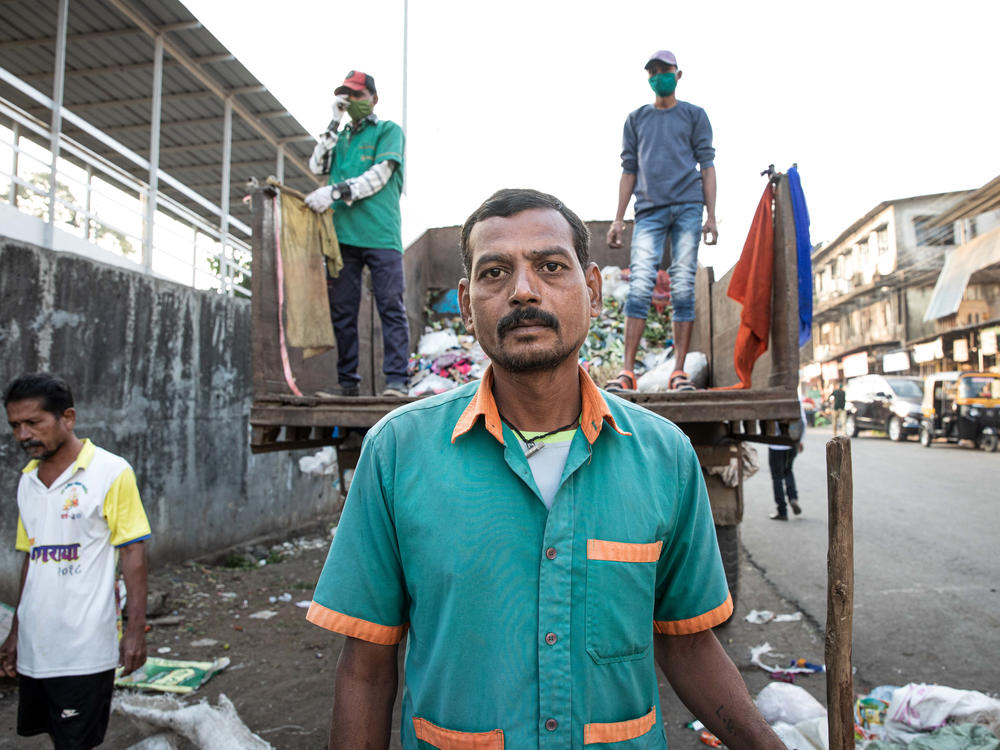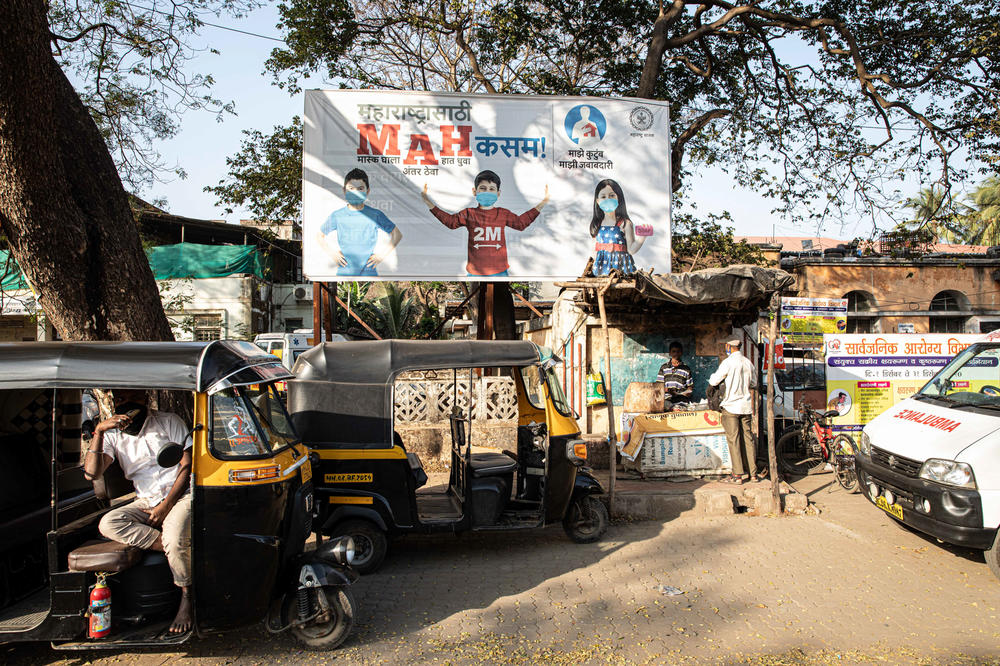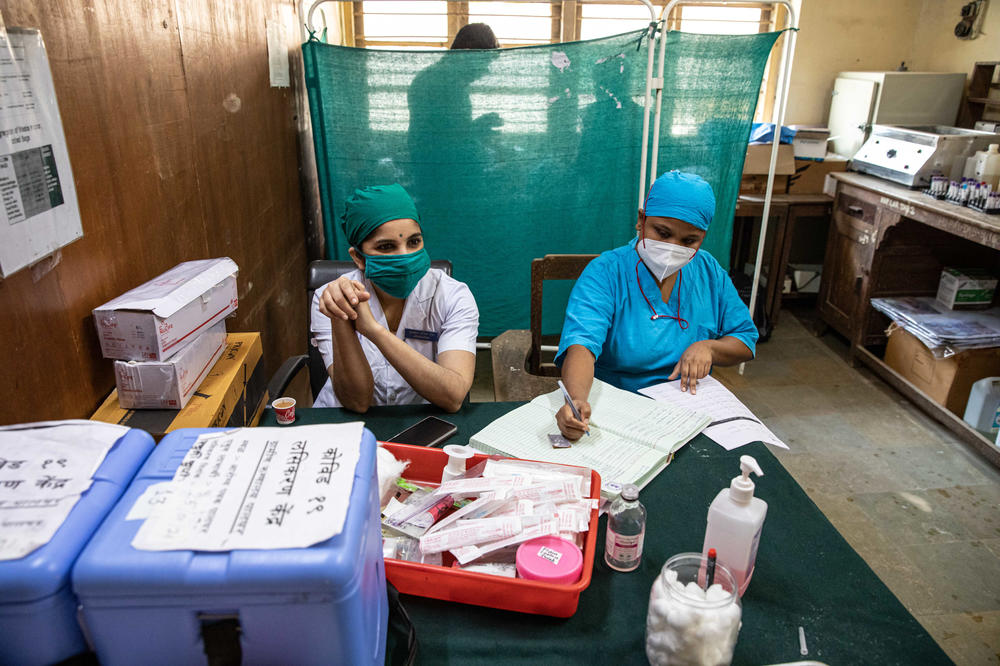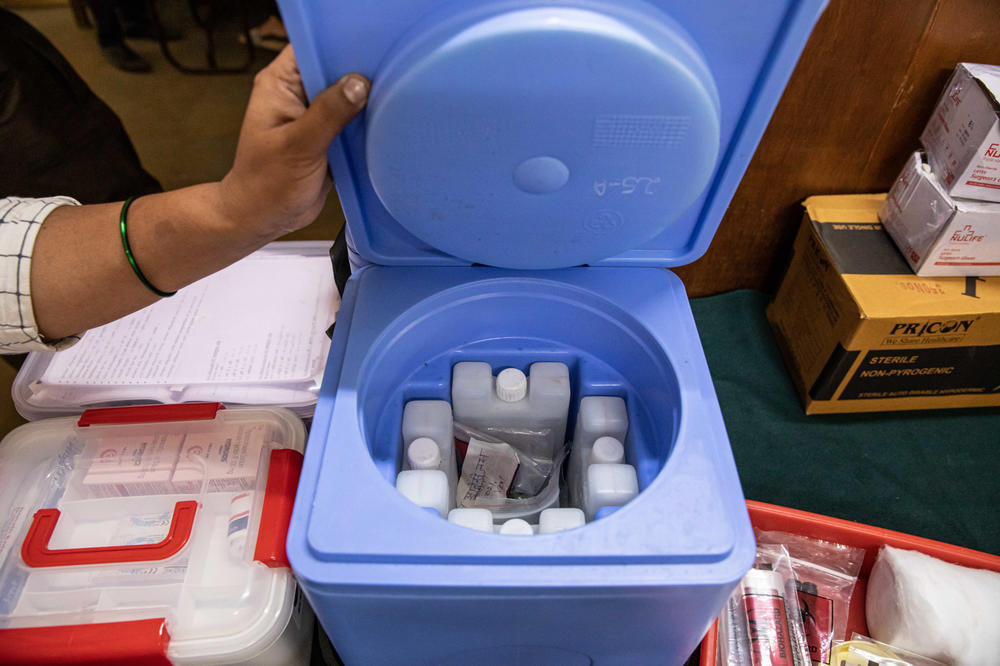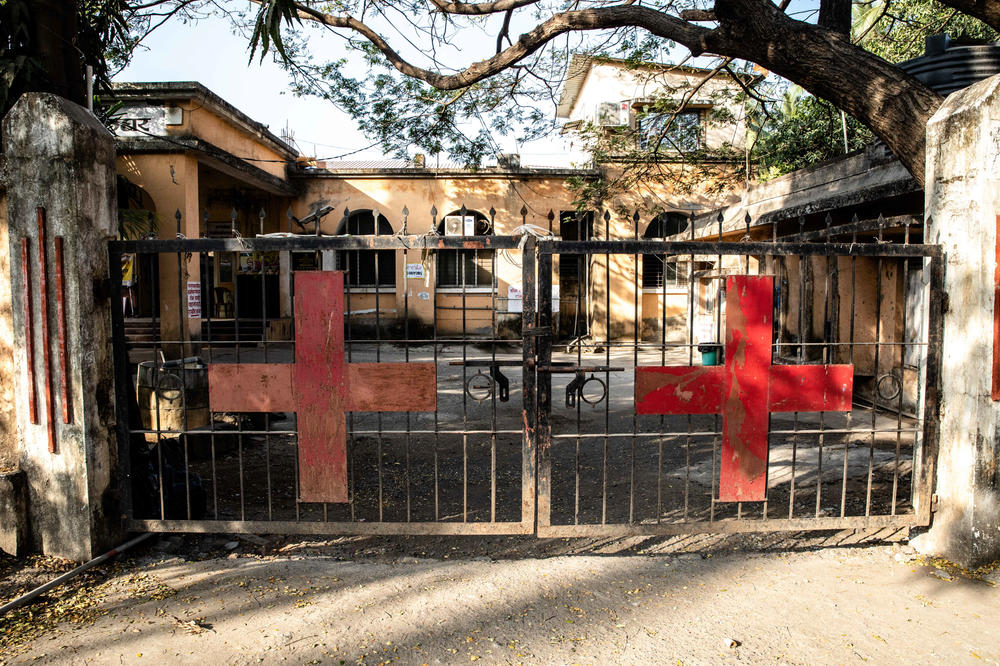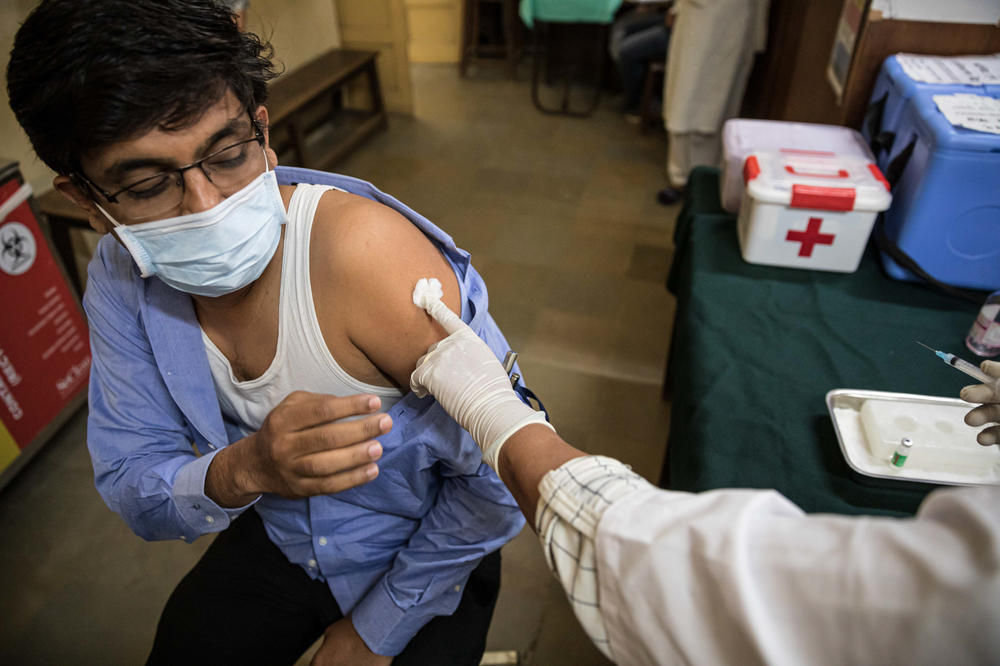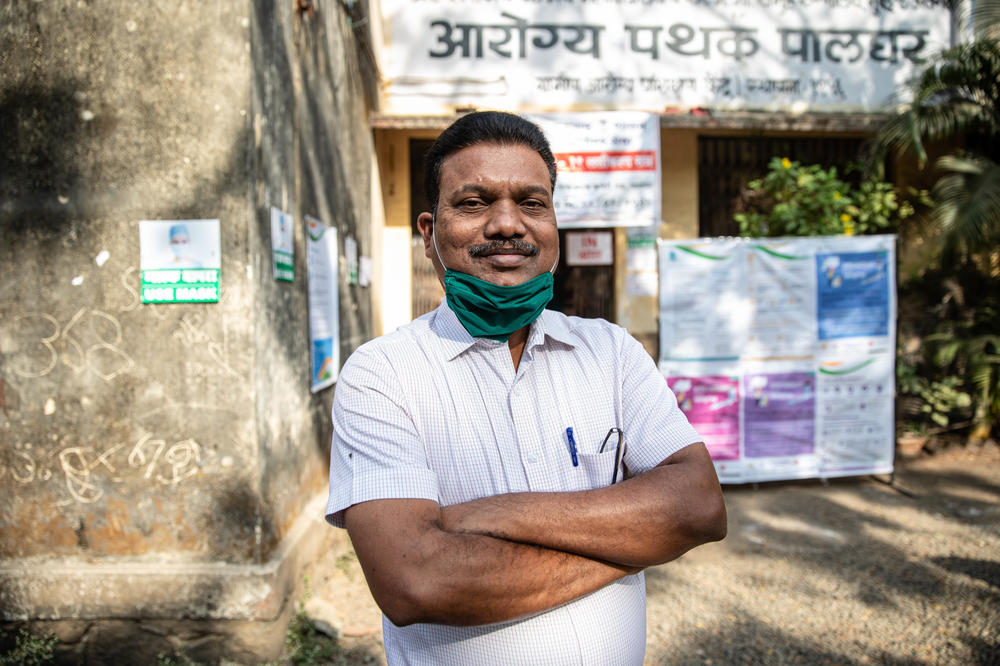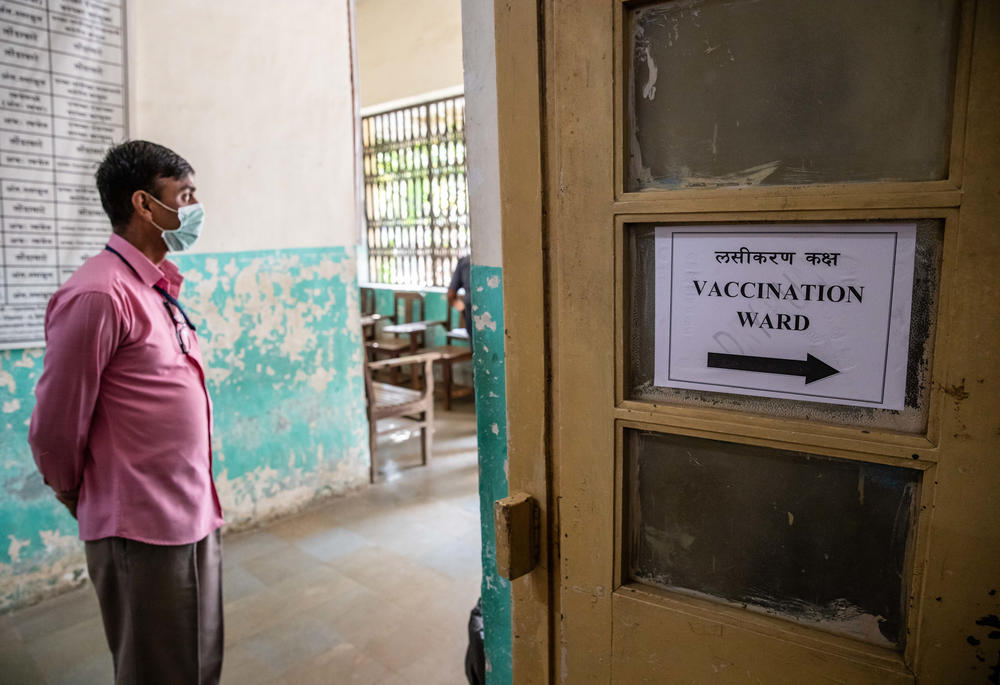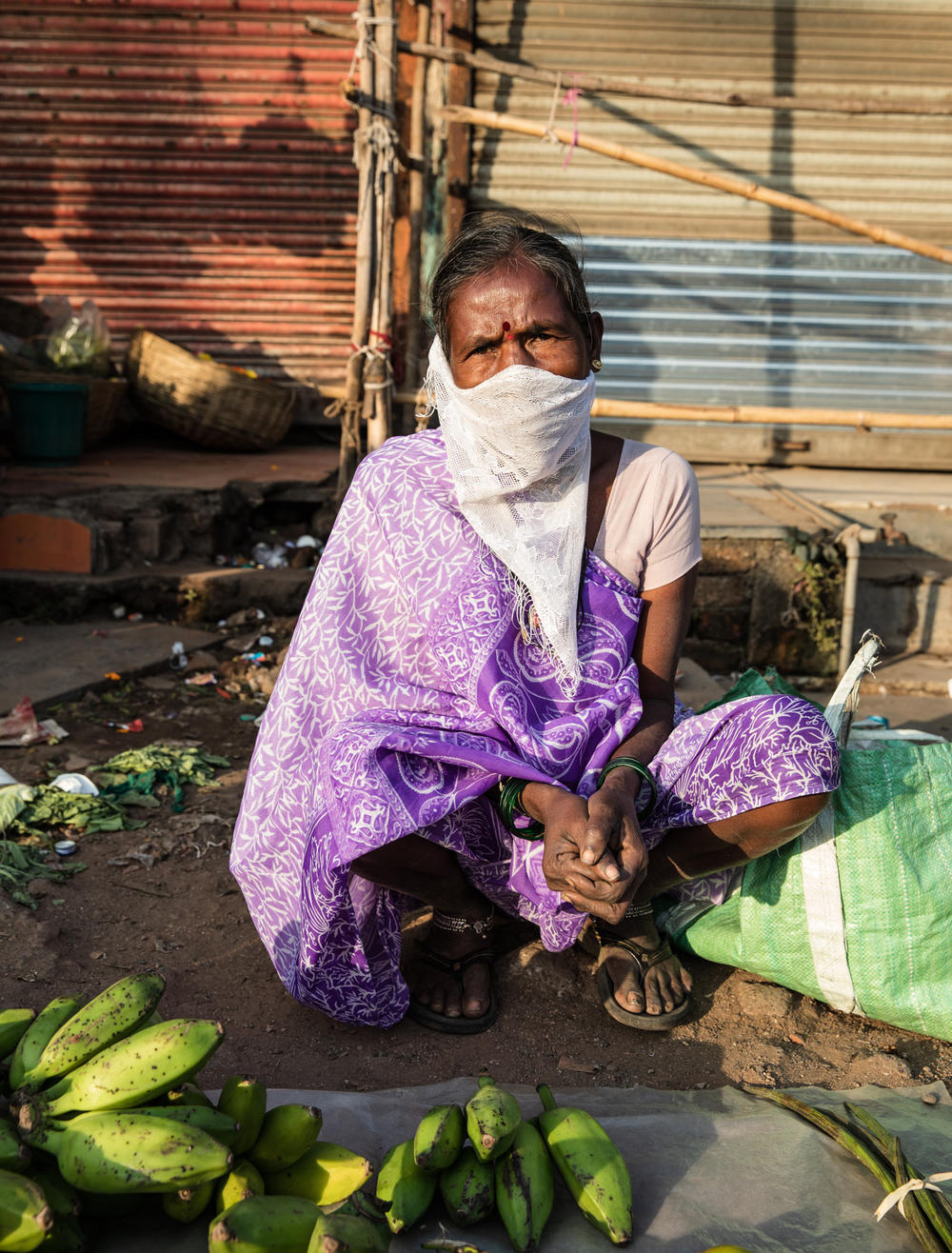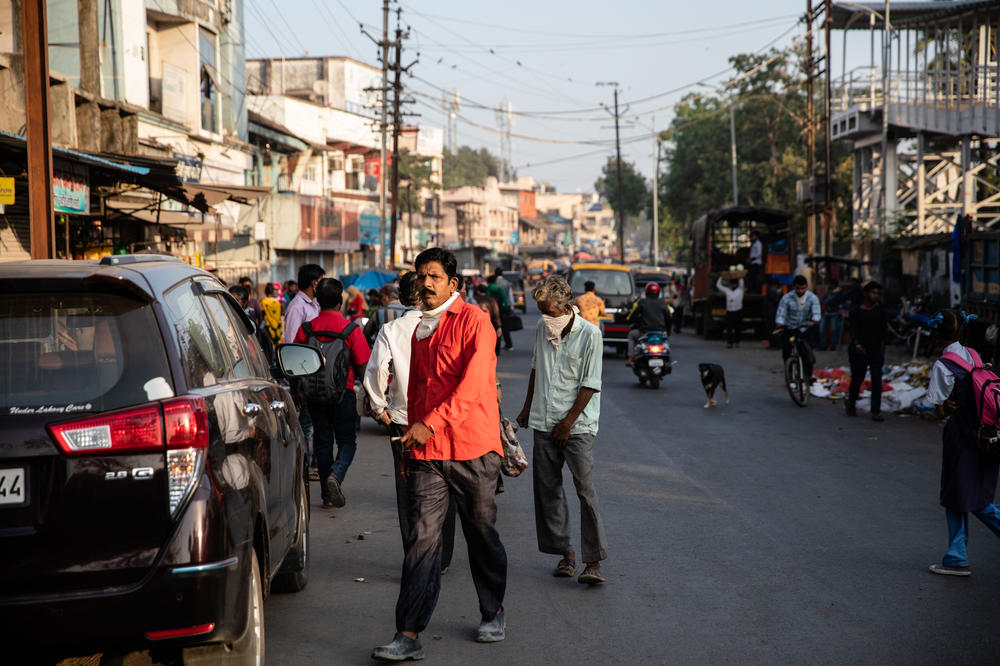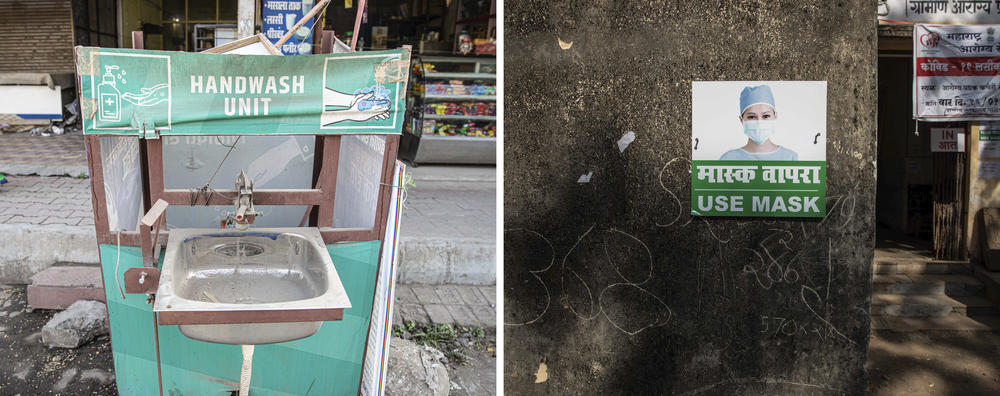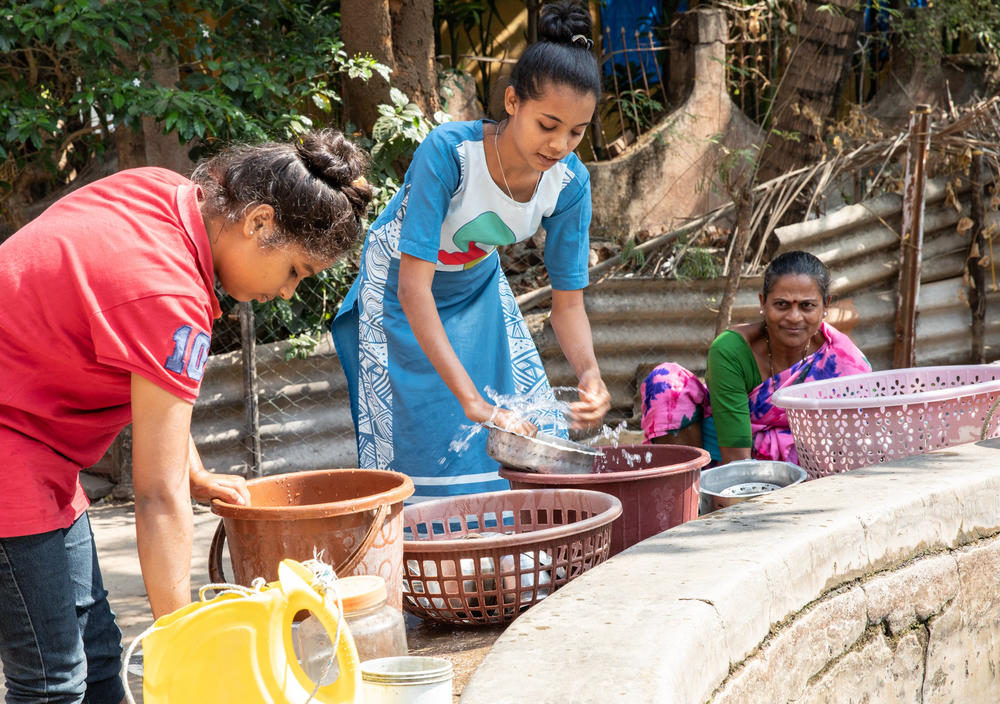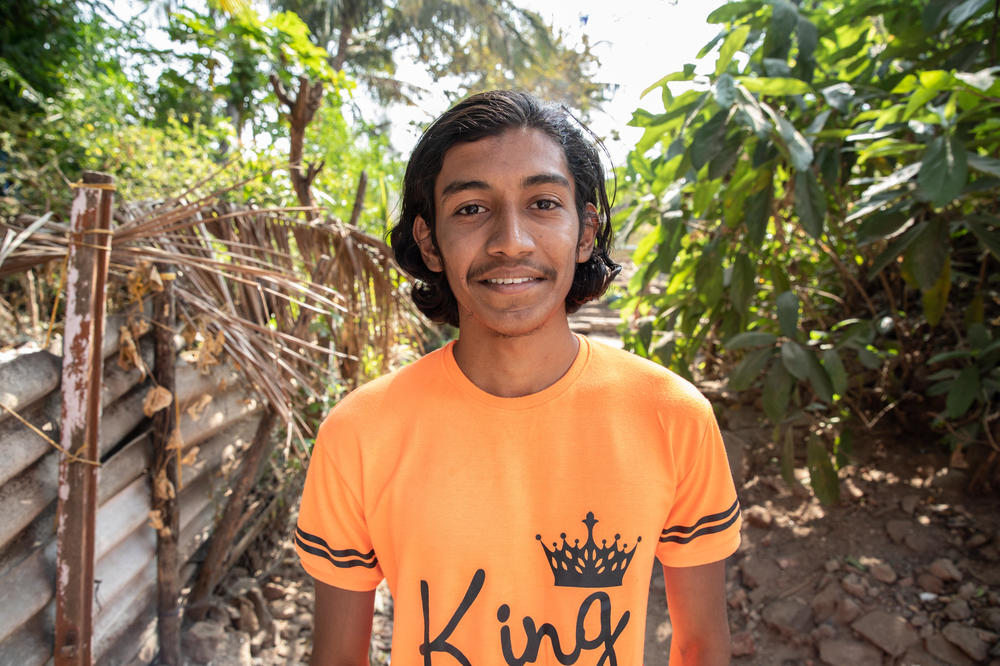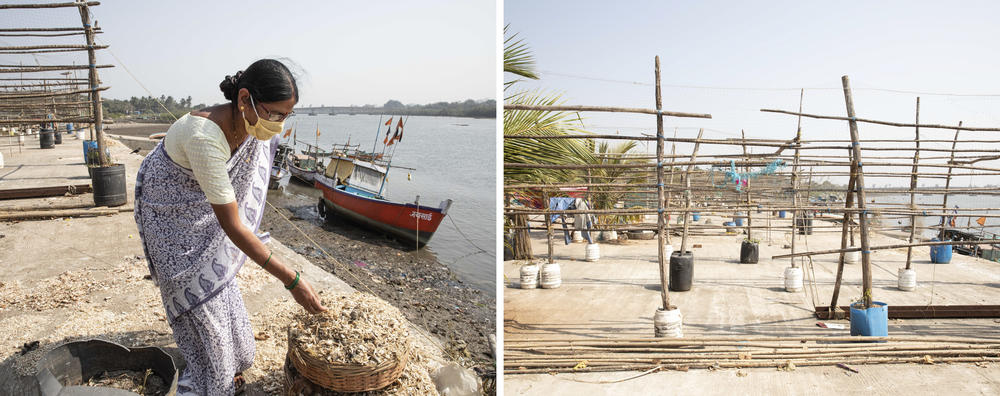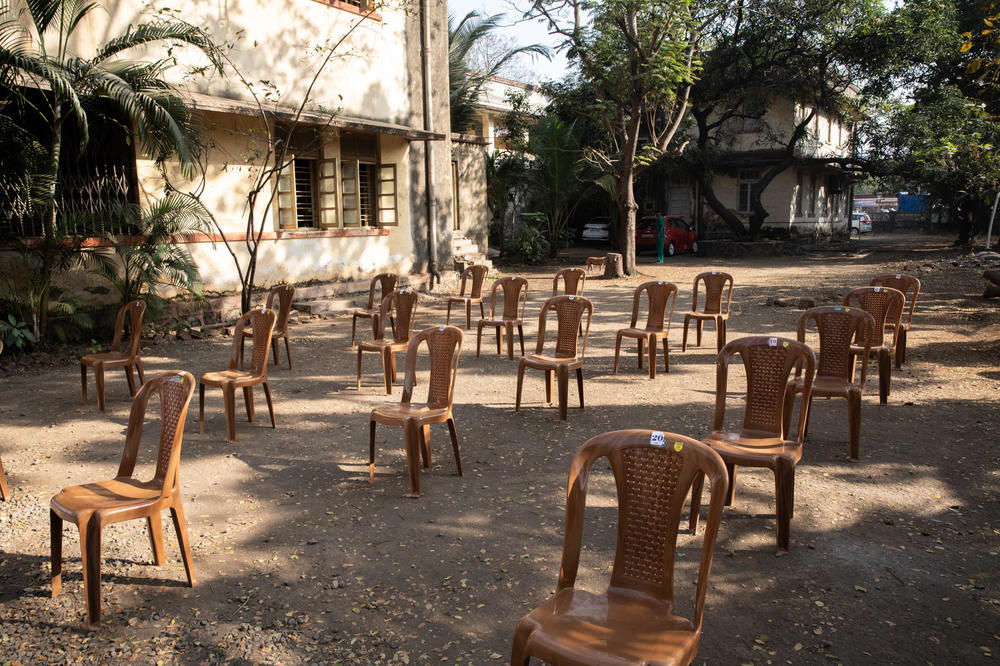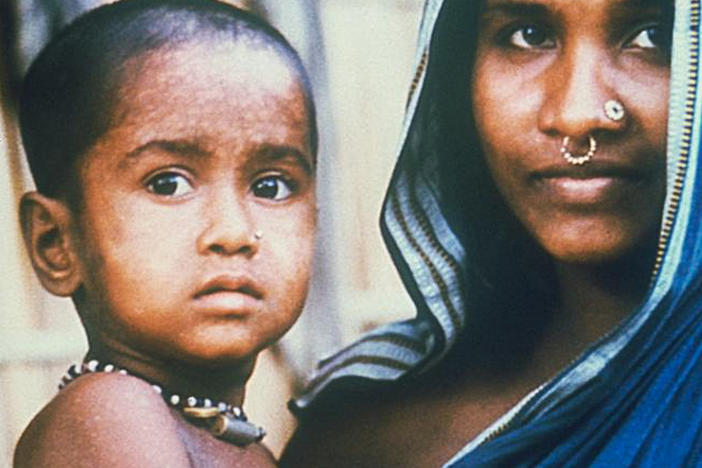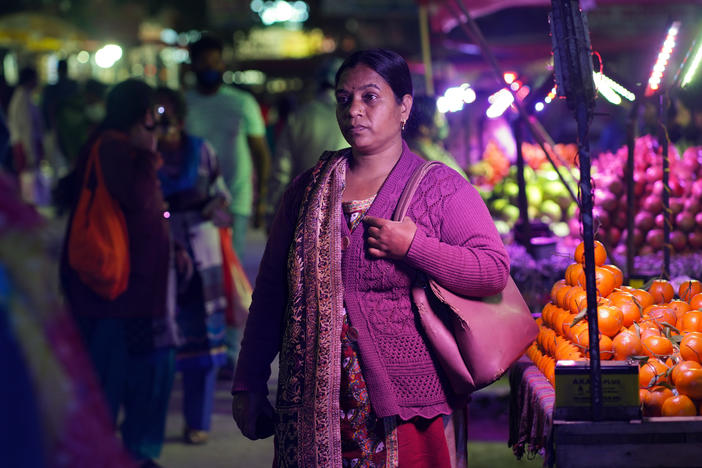Section Branding
Header Content
PHOTOS: The World's Biggest Vaccine Campaign Has Begun In India
Primary Content
Outside a train station in rural India, wiry men in flip-flops rake rotting coconuts and soiled plastic wrappers onto burlap tarps, then sling them into the back of an idling truck. They start toiling at dawn, sometimes scooping trash with bare hands, for a monthly full-time wage of about $95.
But there's at least one thing these men say they feel lucky about: As sanitation workers, they're among the first Indians eligible to get the coronavirus vaccine.
Last month, India launched what Prime Minister Narendra Modi calls the biggest vaccination drive in the world. It aims to inoculate 300 million by mid-summer, though it'll take at least two more years to vaccinate all of the nearly 1.4 billion people in India.
The first phase, now underway, covers all health and frontline workers – about 30 million people – including doctors, nurses, police officers and trash collectors.
"I never felt scared of the virus," says sanitation worker Ramesh Solanki, who wears a tidy teal uniform with orange trim and a Hindu talisman on a string around his neck. "I've been out working the whole time, even during the lockdown. The government is making decisions with our well-being in mind."
Solanki, 45, is just waiting for his supervisor to tell him when his vaccine appointment will be. He'll get his shots without hesitation. "I feel proud," he says.
India has the second-highest coronavirus caseload in the world, behind the United States, though daily case counts have plummeted in recent months. Many frontline workers have been around COVID-19, especially the health workers among them, and have seen what it's wrought. Last May, a video went viral of dead bodies laid out alongside live patients in a Mumbai COVID ward. In Delhi, hospitals were so overwhelmed, there were reports of people dying in parking lots while waiting to be admitted.
In this first stage of the vaccine campaign, all inoculations are being administered at government hospitals. They're voluntary and free of charge. Later, possibly this summer, Indians may be able to pay for vaccines at private hospitals and clinics. Eventually, the government plans to dispatch mobile vaccination teams to the country's most remote corners.
The goal of vaccinating 300 million Indians by later this year is entirely doable, says Akhil Bery, a South Asia analyst at the Eurasia Group, a global think tank.
"More than 20% of the population will be vaccinated [by July or August]. That's not an insignificant number," Bery says. "It will help reduce the burden on India's health-care infrastructure."
The mission is modeled on Indian elections, the biggest exercise of democracy in the world.
Elections stretch out for several weeks and involve poll workers carrying electronic voting machines to hilltop monasteries and villages in the jungle.
"The Election Commission of India has a mandate to ensure that no voter has to travel more than two kilometers [1.25 miles] to be able to vote. The same logic will apply here," Bery says. The government will rely on the same state infrastructure – including those workers who carry the electronic voting machines — to this time, haul vaccines on ice.
And there's another election tie-in. India is using voter rolls to identify people by age to see who's eligible for the vaccines.
Early hiccups
The vaccination center where the sanitation worker Solanki will soon get his shots is in a repurposed wing of the Palghar Rural Hospital, about three hours drive north of Mumbai. The hospital's catchment area includes tribal villages nestled in palm groves, and fishing colonies on the Arabian Sea coast.
Two-thirds of Indians live in rural areas, and if they get any medical care, it's at government hospitals like this one: a mildewed but tidy concrete building behind a rusted gate. In the courtyard, plastic chairs are lined up, six feet apart. There's a blue plastic trough connected to a water tank, for hand-washing. Inside, vaccinations are underway. A guard takes temperatures at the door.
"I'm excited to call my wife. We'll celebrate with the family tonight," says Amit Sonawane, 35, an engineer at the district health office, after getting his first dose. Rubbing his left arm, Sonawane explains how his 2-year-old son and his own brother both survived COVID last month. He's relieved to get vaccinated, he says.
There are occasional hiccups. While all the admin for previous Indian immunization campaigns was done the old-fashioned way — on paper — all registration for COVID vaccines must be done through the government's new CoWIN smartphone app. (So far it's only available to hospital administrators but will eventually be rolled out to the general public.) Technical problems with the app forced the state of Maharashtra to suspend vaccinations for two days last month. Glitches also forced the states of Punjab and Haryana to temporarily waive use of the app, requiring hospital administrators to manually enter data.
Inside the Palghar Rural Hospital, 4G network coverage can be spotty, says Dr. Umesh Dumpalwar, who's overseeing vaccinations there. There are also occasional power outages, but the hospital has a backup diesel generator that kicks in to keep the lights and computers on and oxygen machines running.
Overall, this first phase of vaccinations for frontline workers is the easy part, Dumpalwar says. He's concerned more about the next phase of India's campaign, expected within two months, which will open up vaccinations to anyone over age 50, or with a pre-existing condition. (The reason the age cutoff isn't higher is that India is a relatively young country; only 6% of the population is over age 65.)
"That will be the challenge. Whenever we start with the common man, the common public, there are so many rumors, like, 'it has not been properly trialed,' or 'people will get COVID infections from the vaccine,'" Dumpalwar says, sounding worried.
Palghar is using only the Oxford-AstraZeneca vaccine — one of two formulas granted emergency authorization by the Indian government, though Modi says more are in the pipeline. The government allocates certain vaccines to certain districts, and recipients cannot choose. The other vaccine is a homegrown formula developed by an Indian company called Bharat Biotech. It was approved for use while still in phase three clinical trials without full efficacy data. Public health experts, scientists and opposition politicians have raised concerns.
Suspicious minds
Around the corner from the Palghar hospital, women in multicolored saris squat in the road, hawking vegetables in neat little piles laid out on blankets: dirt-coated potatoes, shrunken cucumbers, green bananas and bruised tomatoes. One of them, Kunta Dubra, takes the train for an hour each morning, from an even more rural area, to sell her meager harvest. Along the way, she hears chatter about the coronavirus and the vaccine, but she doesn't know anyone who's been sick.
She also doesn't know her own age. She never went to school.
"Why would I take medicine if nothing's wrong with me?" she says when asked if she'll take the vaccine.
Dubra also doesn't have a phone. So when vaccinations open to the general public, she won't be able to receive a text message from her district health office, telling her when she's eligible. And she has no way to download the government's Co-WIN app.
Next to her, women pull their dupatta headscarves down around their mouths as masks, leaving only a narrow slit to see through. They eye visiting reporters with suspicion. One woman says she has high blood pressure, and that NPR's microphone – she'd never seen one before — makes her uneasy. She's worried it could give her the coronavirus, she says.
Last April, two Hindu ascetics from another district tried to drive through back roads in Palghar, during a nationwide coronavirus lockdown. Suspicious of outsiders, locals attacked their car, killing the two men and their driver.
To meet its goal of vaccinating more than 20% of its population this summer, India needs to reach people like this, in rural poverty – where rumors, disinformation and fear run rampant. And it needs to be vaccinating them at a rate of at least a million-and-a-half people per day. So far, it's been doing a few hundred thousand daily.
Unlike many global leaders, Modi has not yet taken the vaccine, at least not publicly. Many Indians applaud him for waiting his turn and not jumping the queue. But opposition politicians have accused him of failing to lead by example, and fueling vaccine hesitancy.
How vaccine hesitant is India?
Before coronavirus vaccinations began, global surveys generally showed less vaccine hesitancy in India than in the United States and other countries. India has successfully eradicated many diseases through mass immunization campaigns. It was officially declared polio-free in 2014.
"This isn't the first immunization campaign for us. We've been doing this since the 1950s with smallpox and polio. We've been collecting people from their homes or doing home visits," Dr. Dumpalwar says. "So we have the manpower and the systems. It's all already there."
Urban and rural areas are plastered with billboards touting COVID vaccines. Whenever you make a phone call in India – landlines or mobile – instead of a ringtone, you hear a government message saying, "When it's your turn, do take the vaccine... and don't believe in rumors."
But with vaccinations now underway, more recent surveys show higher than expected public uncertainty. In a survey of 25,000 Indians published Thursday, 58% of respondents said they are hesitant about taking the coronavirus vaccine immediately. But that figure was 16% lower than in an identical survey taken one month earlier, suggesting that public awareness campaigns may be working, and that attitudes are changing quickly. Both surveys were conducted on social media by LocalCircles, an online community forum that conducts polls about governance and consumer interest.
In rural Palghar, locals wash dishes in a communal well, and chat about how they don't know anyone with COVID-19. The number of coronavirus cases confirmed nationwide has dropped from a peak of nearly 100,000 cases a day in September to under 9,000 one day this past week. Scientists are trying to figure out why.
"The pressure is off. The fear is gone. No one has COVID here," says Akash Chawan, a 19-year-old amateur cricket player who left college in Mumbai to take refuge with relatives in the countryside. "In Mumbai, it's a different situation. You feel like you're in a pandemic. But here, people are taking it more lightly. The cases have gone down. We can move freely like we used to live before."
When it's his turn, Chawan says he's unsure if he'll take the vaccine. He thinks the worst of the pandemic might already be over. Maybe he won't need the vaccine, he says. A recent serological survey showed 56% of residents in India's capital have COVID antibodies, suggesting prior exposure to the virus.
"I think most people are waiting for more information," Chawan says.
He's not alone. In the latest LocalCircles survey, 51% of respondents said they want to wait at least three months before making a decision about whether to take the vaccine.
Beyond the mangroves that line rural Palghar's Arabian Sea coast, fishermen's wives spread shrimp husks in a thin layer on the ground to dry in the sun. A cement pier overlooking a muddy inlet is lined with wooden frames where they'd normally hang fish to dry. But the scaffold is empty.
Women hunker over buckets, shucking oysters, and commiserate about the economy. A nationwide lockdown last spring meant they couldn't take their boats out on the water. Markets were shut. The Indian economy nosedived into an unprecedented recession.
Would taking a vaccine bring life back to normal, the women ask?
"We've faced so many difficulties over the past year, and we had to survive off savings," says Lakshmi Prakash Tandel, 45, in a lavender and white sari and a bright yellow face mask. "But we're unsure about taking the vaccine. Some people say you can fall sick after taking it. Other people say it's good. So that's the question in our minds."
Waiting for arms to inoculate
As dusk descends on Palghar Rural Hospital, chairs are still lined up in the courtyard at a safe distance apart. But many are empty.
"We're just waiting for patients, waiting for beneficiaries," says Dr. Dumpalwar, pacing.
On the day NPR visited in late January, 115 frontline workers had appointments for vaccinations, he says. But by late afternoon, only 55 had shown up.
Vaccine supplies are not a problem in India. It's home to the world's largest vaccine-producing company, the Serum Institute of India, headquartered in the city of Pune, about 150 miles from rural Palghar.
Even before any vaccines went through clinical trials or were approved by governments, the Serum Institute took a gamble: Last summer, it started mass-manufacturing five untested vaccines. If they eventually worked and got approved, the company would have hundreds of millions of doses ready to distribute.
The Oxford-AstraZeneca vaccine was one of them. Serum has since signed agreements with India and several other countries to export that formula. It's likely to be the COVID vaccine most used in lower- and middle-income countries, and in rural areas, because it does not require ultra-cold refrigeration. Serum is now manufacturing 100 million doses of the Oxford-AstraZeneca vaccine a month, half of which are earmarked for India.
Back among the rotting coconuts and trash outside Palghar's train station, sanitation worker Solanki labors away, waiting for his supervisor to tell him when it's his turn to get vaccinated. He doesn't need convincing.
"I get up every morning at 5:30, and I see news about the vaccines on TV. I don't know about any controversies," he says. "I just know I'm proud to be part of this."
NPR producer Sushmita Pathak contributed to this report.
Copyright 2021 NPR. To see more, visit https://www.npr.org.
Bottom Content

